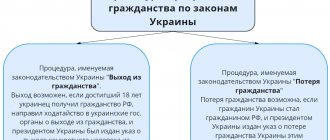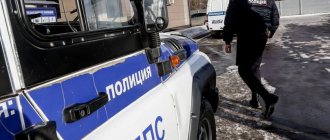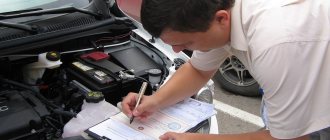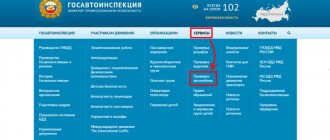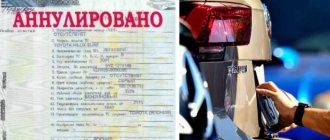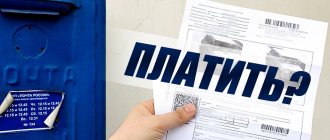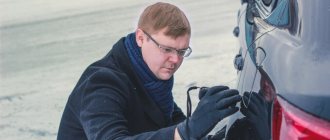Inspection and search procedures have been controversial issues in Russian legislation since their introduction. Many drivers do not know their rights and allow inspectors to violate them. Some, on the contrary, having read some erroneous and superficial articles on the Internet, begin quarrels with inspectors who want to conduct an inspection, thereby provoking traffic police officers to impose punishments. So, the time has come to understand all the intricacies of carrying out inspection and inspection of cars, and this article will help with this.
Punishment for refusing inspection
For obstructing the inspection, you can get not only a fine, but also arrest. The punishment is introduced by Art. 19.3 of the Code of Administrative Offenses – disobedience to a lawful demand of a police officer. The fine ranges from 500 to 1000 rubles. A 50% discount for payment within 20 days is not provided, since this is not a violation of the Traffic Rules. But, despite the lack of a discount, the fine amount is quite insignificant, which cannot be said about the second type of punishment for this offense - administrative arrest. The driver can be arrested for up to 15 days, which is really much worse than even the maximum fine under this article.
However, a fine is imposed by an inspector right on the road, and an arrest can only be ordered by a judge. At the same time, in court the driver will have the opportunity to protect his rights and even seek the help of a lawyer. If the driver is generally a law-abiding citizen, and when communicating with the policeman did not physically influence him and behaved adequately, then he will not face arrest.
How to protect your rights?
The Code of Administrative Offenses quite clearly regulates the procedure for inspecting a car. However, referring to it directly on the road can be useless. You should not get into an altercation with an overbearing inspector. It is better to take the position of an observer. If you take photos or videos, be sure to involve witnesses.
When the protocol is drawn up, the driver has the right not only to familiarize himself with it, but also to make comments and disagreement with the actions of the police officer/s. And sign. And then go and complain: to the higher management of the inspectors and to the court.
Many traffic police officers are arrogant and believe that drivers do not know their rights and the norms of current legislation. Therefore, officials make grave mistakes:
- conduct searches with fewer, or even no, witnesses;
- do not draw up a protocol;
- conduct a search without a driver;
- They move things during the inspection procedure and rearrange them themselves.
And all this is a reason to appeal against the illegal actions of law enforcement agencies (seemingly).
The main task of search and inspection
These procedures are carried out by police with one purpose - to discover evidence of an offense or the subject of its commission. The inspection, of course, allows you to see less, for example, an unbelted passenger or a child traveling without a special child car seat. The inspection allows the inspector to get into the car himself to find, for example, removable tinting or curtains that the driver removed in front of the inspector.
In order for these goals to become the basis - a sufficient condition allowing an inspection - the inspector must not just have an assumption about the possible presence of this item in the car, he must have seen it himself. Unfortunately, he is under no obligation to prove his observation.
The main differences between a search and a car inspection
Inspection or inspection? For most motorists, the differences in these concepts are insignificant or completely unnoticeable. But from the point of view of the law (Administrative Regulations approved by Order of the Ministry of Internal Affairs of the Russian Federation No. 664 dated August 23, 2017), the difference between them is significant. It's easier to track it in a table.
| Procedure name | Characteristic | |||||
| Formulation | Driver's consent | Exit from the passenger compartment for the driver and passengers | Examination of personal belongings in the car | Availability of grounds | Protocol | |
| Inspection | Visual examination of the vehicle without entering inside | + | — | — | — | — |
| Search | Actual content control | — | + | + | + | + |
In addition to the above wording of the actions of authorized persons when stopping a car, there is another one - “search” . The Law “On the Police” states that as part of these manipulations, the inspector can independently touch and move things inside the vehicle and violate its integrity . But the search is preceded by:
- Initiation of a case
- Issuance of the relevant resolution
If an inspector classifies his actions as an inspection, but independently opens the bags in the car, lifts the seats, opens the hood, and so on, then he violates Art. 27.9 of the Code of Administrative Offenses of the Russian Federation and may be punished with a fine of 20,000 rubles.
Differences between vehicle inspection and similar procedures
In addition to inspecting the vehicle, police can also conduct an inspection of the vehicle, search of belongings, and personal search of the driver and passengers. All these concepts are not the same procedure. However, not all drivers can explain the difference between them, which means it will be difficult for them to protect their rights.
Differences between search and inspection
Morphologically these words are quite similar, but legally these procedures have a huge difference.
Inspection is a visual, exclusively visual acquaintance with the contents of the car, its technical condition, and its passengers. That is, the inspector can look out the window and walk around the car itself, but cannot touch objects. In fact, a traffic police officer conducts an inspection every time he stops a car.
Inspection is a more serious procedure that allows the inspector not only to inspect the car, but also to touch the objects in it, demand that the driver and passengers get out of the vehicle, and also sit in their seats. Such an action already requires a basis, which will be discussed below. The search must be carried out in the presence of 2 witnesses who will monitor the actions of the policeman, and upon completion of the procedure they will sign the search report - this will be proof that the object found in the car was not planted by the inspector and that the entire procedure was carried out in accordance with the law . Instead of attracting witnesses, the inspector can make a video recording.
Differences between vehicle and personal searches
Employees of the State Traffic Inspectorate can conduct not only an inspection of the vehicle, but also an inspection of things and a personal search. These are 2 more serious actions for which separate protocols must be drawn up. And for each of them, witnesses are needed. Important! Only a police officer of the same gender as the person being searched can conduct a personal search; witnesses must also be of the same gender.
What are the differences between these 3 processes? Inspection of a vehicle should be limited only to checking the contents of the car: the inspector is prohibited from opening bags, suitcases, packages, etc. lying in it. A personal search is a check of things on a person; it allows you to require the removal of accessories, part of clothing and take things out of pockets. Inspection of personal belongings means that the inspector will check bags, briefcases, suitcases, boxes, containers, and so on.
Differences between inspection and search
Another, at first glance, similar concept is a search. But in reality there is a huge difference between an inspection and a search.
The legal difference is that the search is conducted as part of a criminal investigation. That is, the traffic police inspector does not have the right to conduct a search when stopping a random driver. A search can be carried out only after the initiation of a criminal case, and employees of the Ministry of Internal Affairs must have an authorization document - an investigator’s resolution (or a court order, if the search is carried out not in a car, but in a home).
The practical difference is that during a search, police officers can violate the structural integrity of the car: break out panels, open the trim, disassemble some parts, and the like. Often, after a search, some parts of the car turn out to be broken or damaged, and the likelihood of receiving compensation for the damage caused is quite small.
Search concept
An inspection of a car by a traffic police officer involves a thorough examination of the contents of the car. The process can affect not only the trunk, but also other parts of the vehicle, so the interior is often checked, the seats are moved and even the covers are removed.
The procedure must be carried out carefully to ensure that no damage is caused to the structural integrity of the vehicle.
Each car is the private property of the car owner, so inspection is permitted only if there are compelling reasons. The inspection rules are prescribed in the regulations of the traffic police and the Code of Administrative Offenses.
Reasons for inspection
As already mentioned, the inspection is actually carried out by an inspector, even when he simply looks into the car window to check whether the drivers are wearing seat belts or whether children are in special seats. However, sometimes the inspector will require you to open the rear tinted window or hood. If at the same time he does not touch the things in the car, this is also considered an inspection. However, such demands already require grounds. They are enshrined in paragraph 197 of Order No. 664:
- any information that the vehicle or its cargo is used for illegal purposes;
- the need to check the license plates of the car and compare their numbers with information from the STS;
- signs of discrepancy between the transported cargo and the information from the document for it.
The wording of the justifications is quite vague, and no other legislative act, unfortunately, explains or specifies them. The first point means that an inspection can be carried out based on any testimony of witnesses, oral instructions transmitted from the previous traffic police post, and so on. The second point is even stranger, since it remains unclear in which cases the traffic police inspector needs to check the engine, chassis and body numbers with information from the STS. We can say that this need appears when he has reason to believe that the car is stolen, but this is unlikely to bring any clarity. The last, third argument also does not contain any specifics.
Based on paragraph 197, it can be said that Russian legislation does not establish clear and specific grounds for inspection, which essentially allows inspectors to conduct it whenever they want.
Search or inspection, what's the difference?
Many drivers simply do not think that inspection and inspection of a vehicle are different events. And so inspectors often do what they want, rightly believing that the person behind the wheel will not complain. Because he simply won’t understand that something illegal happened.
Meanwhile, just like that, without any reason, a traffic police officer can only conduct an inspection of the car, without any search. But here, of course, you need to understand the terminology.
What is an "inspection"? Just an external review of the vehicle for registration and/or verification purposes . In other words, all the police can do is inspect the interior through the glass, yes, ask the driver to open the hood to check the license plate. This is all.
But inspection is a completely different matter. Here we are talking about control over the actual contents of the car. And for this we need reasons.
In what cases does the inspector conduct an inspection? There are a few of them:
- During special operations.
- To verify numbers (from PTS) and special markings.
- When vehicle malfunctions are detected, when further operation of the vehicle is prohibited.
- If the vehicle cargo does not correspond to the information about it in the accompanying documents.
And if a traffic police officer informs the driver that he will conduct an inspection, the latter should not even leave the passenger compartment or cabin of the car. The most he can do is open the hood. And then even a room stained with dirt must be cleaned by an inspector. More precisely, the driver is not obliged to do this, therefore, since the policeman needs the numbers, he will clear them himself.
The main differences between an inspection and a search are:
- voluntariness of the first;
- the procedure itself (in the first case, free, in the second, regulated by law);
- grounds for carrying out (during the inspection, “it seemed” enough, but during the inspection, more significant and compelling reasons are needed).
Grounds for inspection
Now let's look at the reasons for car inspection; this is a more important topic, because the procedure itself is more serious.
According to paragraph 202 of Order No. 664, the basis may be information that in the vehicle:
- weapons, ammunition, explosives, drugs, radioactive substances, etc. are illegally transported;
- there are objects of an offense (for example, removable tinting);
- there are people who need to be detained.
This information should be in the form of guidance, but the State Traffic Inspectorate employee should not provide any document. The orientation may be at a stationary traffic police post, or it may even be verbal, transmitted from another traffic police post.
To check the presence of an orientation that served as the basis for an inspection, you need, firstly, to ask the inspector himself about its availability, and secondly, if the first step does not produce results, call the traffic police duty station (its number is written on the side color scheme of the patrol car ).
Rules for the process
The inspection procedure by traffic police officers must be carried out in the correct sequence of actions and taking into account many rules. The basic rules are listed in Art. 664 Code of Administrative Offences. These include:
- it is mandatory that two witnesses are involved in the vehicle inspection procedure by a traffic police officer, who are independent persons who are not interested in the outcome of the process;
- It is not allowed to involve traffic police inspectors or car passengers as witnesses;
- Video recording is permitted if for various reasons it is impossible to find witnesses;
- the inspection is carried out only in the presence of the car owner, but in extreme cases the process is allowed without his participation, when wasting time can lead to negative consequences;
- if the car contains sealed cargo or items controlled by customs authorities, then the traffic police officer must contact the duty officer of the Ministry of Internal Affairs for instructions on further actions, since he can independently open the cargo only if there is a threat to people’s lives or the security of the country;
- Video recording and photographs are used to record various actions and found objects;
- It is not allowed to leave the driver and passengers in the car during the search, since in most cases they are suspects in various crimes, so additional detention measures are often applied to them.
If the traffic inspector violates the above rules, the driver can write a complaint against him or immediately call the duty station. If no suspicious or dangerous objects are found, the traffic inspector must release the driver.
Search rules
Here is a short list of the most important inspection rules that every driver should learn:
- The search must be carried out in the presence of 2 witnesses found right at the stop site. Other police officers and any people known to the inspector before the start of the search cannot be involved as witnesses. There is no need to involve witnesses; the inspector records the process on video.
- Vehicle inspection cannot be carried out in the absence of the vehicle owner. However, the driver and all passengers should not be directly in the car.
- The police do not have the right to prohibit the owner or witnesses from videotaping the search.
- The inspector can open the doors, windows, trunk, hood and glove compartment with his own hands; move and even remove any objects from the car.
- During a vehicle inspection, the inspector does not have the right to:
- open bags, packages, boxes, etc.;
- violate the structural integrity of the car (remove panels, trim; it is forbidden to even pull out the cigarette lighter).
- If the inspector has discovered the subject of an administrative violation, he must draw up a corresponding protocol. If weapons, explosives, drugs, etc., or a person who should be arrested, were found, the inspector may call a task force.
- Before the start, an inspection protocol is drawn up, which at the end is signed by the motorist, witnesses and the policeman. If, in addition to it, a protocol on an offense or on an arrest/detention is drawn up, then notes about the inspection are also included in these protocols.
- The vehicle owner must receive copies of all protocols.
Inspection protocol
Art. 27.9 of the Administrative Code obliges police officers to draw up a vehicle inspection report before starting the procedure. An exception is the need to detain persons in a car, then the fact of the search can be included in the arrest report, and a separate document is not required for it.
The inspection protocol must contain:
- information about the time and place of the procedure;
- personal data of the State Traffic Inspectorate employee (full name, rank and position, unit);
- personal data of the car owner;
- information about the car (make and model, license plate number, etc.);
- description of the things found;
- personal data of witnesses (full name, residential address, telephone number);
- a note about recorded video evidence, if available (the driver can also make this note if the recording was not made by the inspector).
At the end, this document is signed by the inspector, witnesses if available, and the driver. The driver has the right to refuse to sign - this is his right, but it is better to avoid this. All necessary notes should be made in the protocol, violations of the procedure, if any, should be indicated, and at the end, signed.
Regardless of the results of the procedure, a copy of the protocol must be given to the driver on the spot.
Difference between processes
There is a difference between inspection and inspection, so you should understand the features of the processes:
- During the inspection, the traffic police officer only visually examines the car, but does not have the right to open the doors, lift the hood or ask the driver to open the trunk and get out of the car. During the inspection, it is not necessary to draw up any official documents, therefore a protocol is not formed, and no witnesses are involved.
- A search is carried out only if there is a special warrant. During the implementation of this process, it is required that the driver and passengers leave the vehicle. It is allowed not only to visually inspect the contents of the car, but also to even remove covers, panels, trim or other elements. All items are allowed to be touched, but their integrity must not be violated.
- An inspection of a vehicle by a traffic police officer involves examining the contents of the vehicle. For this purpose, the traffic inspector draws up an appropriate protocol and attracts witnesses. The car owner cannot refuse the process if the traffic police officer has compelling reasons. Therefore, you will have to open the trunk, car doors and hood.
If during any procedure no problems or irregularities are detected, the driver can continue driving.
Inspection rules
Legally, after the inspection, it is also required to draw up a certain document - a vehicle inspection report (clause 200 of Order No. 664). Technically, even if the inspector looked into the car through the driver's window, he has already conducted an inspection and must draw up a report. But neither drivers nor inspectors are interested in unnecessary paperwork and wasting time, so in practice, if no violations were found during the inspection, no documents are drawn up.
If during the inspection the inspector noticed any violations, an inspection report will still have to be drawn up. In terms of content, it almost completely repeats the inspection protocol, but the report is drawn up after the procedure, and not before it.
Is it legal to ask to open the trunk?
To begin with, it is necessary to indicate that a request and a demand are completely different concepts. The driver can refuse the inspector any request, but he must comply with legal requirements.
If an employee of the State Traffic Inspectorate wants to check the contents of the trunk, the driver has the right to refuse or demand a vehicle inspection protocol. If the driver is engaged in cargo transportation and must have documents for the cargo being transported, then checking this cargo is an inspection. Also, checking the trunk can be considered an inspection if the inspector did not demand, but rather asked to open it, and the driver voluntarily agreed. It makes no sense to demand an inspection report after this, but you can demand an inspection report.
Article 27.9 of the Code of Administrative Offenses of the Russian Federation. Vehicle inspection (current version)
Commented article. 27.9 of the Code of Administrative Offenses of the Russian Federation is devoted to the procedure for inspecting a vehicle.
1. An inspection of a vehicle is fundamentally little different from a personal search and an inspection of things in the possession of an individual. In both cases, the purpose of the search is to detect instruments or objects of an administrative offense. An inspection is an examination of a vehicle without violating its structural integrity, that is, disassembling any parts of the vehicle is not allowed (for example, during such an inspection the trim cannot be removed, even if it is later restored). However, the inspection person has the right to demand access to all elements of the vehicle, which can be achieved without violating the structural integrity (to the interior, luggage compartment, engine compartment, etc.). In the absence of consent, as well as the active opposition of the owner, such access may be carried out forcibly.
2. The same persons who carry out personal searches and searches of things in the possession of an individual have the right to carry out an inspection of a vehicle.
3 - 8. The procedure for inspecting a vehicle and its documentation also do not fundamentally differ from the procedures provided for in Art. 27.7 Code of Administrative Offenses of the Russian Federation. It can only be noted that, as a general rule, an inspection of a vehicle is carried out in the presence of the person in whose possession it is located, and only in urgent cases can the inspection be carried out in the absence of the specified person. Unfortunately, the article under comment does not indicate in what cases it is permissible to inspect a vehicle in the absence of the owner. It seems that these, for example, may include a situation where the driver abandoned the vehicle after committing a traffic accident, another offense or crime, etc.
In the latter case, the vehicle inspection report must reflect the reasons why the inspection was required in the absence of the owner. In this case, the owner of the vehicle can be not only the owner, but also any person in whose actual possession it is.
Carrying out an inspection of a vehicle by an official in the absence of its owner in the absence of the circumstances provided for in Part 3 of the commented article may be considered a disciplinary offense and result in bringing the said official to disciplinary liability (see, for example: decision of the Kalininsky District Court No. 2-213/ 2014 2-213/2014(2-4847/2013;)~M-6703/2013 2-213-142-4847/2013 M-6703/2013 dated February 4, 2014; Appeal ruling of the Tyumen Regional Court N 33-2143 /2014 of June 2, 2014 in case No. 33-2143/2014; Appeal ruling of the Tyumen Regional Court No. 33-2145/2014 of June 2, 2014 in case No. 33-2145/2014).
Just as when conducting a personal search or searching of things on an individual, when conducting a search of a vehicle, it is necessary either to have two witnesses or to make a video recording. The absence of both entails the recognition of the vehicle inspection report as inadmissible evidence.
EXAMPLE.
By the resolution of the traffic police inspector of the OR State Traffic Safety Inspectorate of the Russian Ministry of Internal Affairs for the Vologda region R. dated DD.MM.YYYY Seleznev A.S. brought to administrative responsibility under Part 1 of Art. 12.5 of the Code of Administrative Offenses of the Russian Federation and was punished with an administrative fine in the amount of 500 rubles. From the contents of the resolution it follows that DD.MM.YYYY for the driver Seleznev A.S. in violation of the requirements of clause 7.3 of the List of Malfunctions of the Basic Provisions of the Traffic Regulations, he drove a vehicle with black objects installed on the front windows, limiting the view from the driver’s seat.
Due to the fact that Seleznev A.S. did not agree with the circumstances of this offense, a protocol on an administrative offense was drawn up, in the content of which Seleznev A.S. indicated the following: “I do not agree with the violation, there were no objects on the windows, there were no measurements, and there were no witnesses either.” From the contents of the protocol it follows that Seleznev A.S. removed the indicated objects from the side windows before measuring light transmittance.
According to the contents of the vehicle inspection report dated DD.MM.YYYY, black objects that were previously installed on the front windows of the vehicle were found in the back seat of the car.
Based on this, the court came to the conclusion that the traffic police officer searched A.S. Seleznev’s vehicle. At the same time, as follows from the case materials, no witnesses were present during the search and no video recording was made. Under such circumstances, the vehicle inspection report is inadmissible evidence.
On this basis, the court made a decision Resolution of the traffic police inspector of the OR State Traffic Safety Inspectorate of the Russian Ministry of Internal Affairs for the Vologda Region of the Republic of April 9, 2021 No. on the involvement of A.S. Seleznev. according to Part 1 of Art. 12.5 of the Code of Administrative Offenses of the Russian Federation and the imposition of punishment in the form of an administrative fine in the amount of 500 rubles is cancelled, the proceedings in the case are terminated on the basis of clause 3 of Part 1 of Art. 30.7 of the Code of Administrative Offenses of the Russian Federation due to the lack of proof of the circumstances on the basis of which the decision was made (decision of the Vologda District Court of the Vologda Region No. 12-272/2017 of June 27, 2021 in case No. 12-272/2017).
At the same time, the inspection of a vehicle provided for in the commented article should be distinguished from such a compulsory measure as inspection of the vehicle and cargo.
The grounds for inspection of the vehicle and cargo are:
— orientations, other information about their use for illegal purposes;
— the need to verify the markings of the vehicle with the entries in the registration documents;
— presence of signs of non-compliance of the transported cargo with the data specified in the accompanying documents for the transported cargo.
Inspection of the vehicle and the cargo being transported is carried out with the participation of the driver or citizens accompanying the cargo. When inspecting a vehicle and cargo under customs control, an employee of the State Traffic Inspectorate compares the data of customs documents with the stamps of the seals.
On conducting an inspection of the vehicle and cargo on the grounds provided for by the Federal Law “On Police”, the employee draws up an inspection report of the vehicle and cargo. The inspection report of the vehicle and cargo indicates the date and place of its preparation, position, special rank, surname and initials of the employee who drew up the report, information about the persons present during the inspection, indicating their surname, name, patronymic (if any), address of the place residence, telephone number, type, make, model, state registration plate, other identification features of the vehicle, type, quantity, and other identification features of the cargo being transported. In the inspection report of the vehicle and cargo, a record is made of the use of photography, filming, video recording, and other established methods of recording material evidence. Materials obtained during the inspection using photography, filming, video recording, and other established methods of recording material evidence are attached to the report.
Based on the results of the inspection of the vehicle and cargo, in the absence of grounds for carrying out other procedural actions, permission is given for the further movement of the vehicle (clauses 197 - 201 of the Administrative Regulations for the execution by the Ministry of Internal Affairs of the Russian Federation of the state function of exercising federal state supervision over the compliance of road traffic participants movement of the requirements of the legislation of the Russian Federation in the field of road safety, approved by Order of the Ministry of Internal Affairs of Russia dated August 23, 2017 N 664).
When conducting an inspection of a vehicle and cargo, the presence of witnesses is not required; accordingly, this is not considered a violation of the inspection procedure (see decision of the Kovdorsky District Court of the Murmansk Region No. 12-11/2015 of March 10, 2015 in case No. 12-11/2015).
Comment source:
Under general L.V. Chistyakova “ARTICLE-BY-ARTICLE COMMENTARY TO THE RF CODE ON ADMINISTRATIVE OFFENSES. PART TWO. CHAPTER 21-32. VOLUME 2"
CHISTYAKOVA L.V. AMELIN R.V. DOBROBABA M.B. CAPTAINETS Y.V. CAPTAIN M.E. MILSHINA I.V. Moshkina N.A. PLESCHEVA M.V. CHELPACHENKO O.A., 2021. Publishing house "RosBukh"
What to do if an inspector violates inspection rules?
Sometimes it happens that the inspector persistently demands to open the trunk, but does not intend to draw up an inspection report. He will not get away with this and any other violation of the law only if the driver takes action in time.
First, you need to turn on the camera and record the entire dialogue with the inspector from the very beginning. Secondly, it is necessary to find out and record his personal data on video. You can even demand his service ID - he is obliged to provide it at the driver’s first request. Thirdly, you need to ask him on the record: is he demanding or asking him to open the trunk? If he demands it, then you need to ask him to draw up an inspection protocol. If he asks, you can politely refuse. In any case, the video will be proof that the driver did not break the law. Video recording should be maintained until the end of communication with the inspector.
If you wrote down that he specifically demands to show the trunk, but does not draw up an inspection protocol, then it is better not to aggravate the conflict and allow him to conduct the inspection. It will be easier to avoid punishment than to receive it and then challenge it.
Using the recorded video, you can file a complaint against the inspector. She may slow down his promotion a little or leave him without a bonus. Also, for the very fact of violation of procedural norms, he is punished in accordance with Art. 19.1 Code of Administrative Offences. Unfortunately, the fine for arbitrariness is very small: only 300-500 rubles.
Other screening features
If for various reasons it is impossible to seize any cargo confirming the commission of a crime or offense, then the traffic inspector makes an arrest, and an inventory of the property is drawn up.
If there is a suspicion that the driver is intoxicated, an examination is carried out. If the breathalyzer shows that the driver really did not have the right to drive the car, then he is removed from driving. If there are significant grounds, which include the presence of serious malfunctions in the car or the absence of a compulsory motor liability insurance policy, the car may be sent to the impound lot.
Can the cops plant anything?
Theoretically, of course, a traffic cop can carefully place something inside a car and immediately find it. This is quite easy to do. However, if the inspector does not have a personal grudge against the driver and if the motorist is not some well-known person who can be paid well for framing him, then the likelihood of fraud is close to zero.
The fact is that traffic police officers must stop violations specifically in the area of traffic rules: their career advancement depends on this. The discovery of drugs will bring them virtually no benefit, but there will be quite a lot of problems. It will all start with paperwork and various reports, and will continue with an investigation by the investigative committee, in which the inspector will be involved. Not a single traffic policeman wants to participate in such a process.
What is a personal search, search of things on an individual?
We decided to make this point separately, since it does not relate to vehicle inspection, but it does exist.
A personal search is an examination of things that are on an individual, without compromising their integrity. The grounds for personal search are also specified in the Order of the Ministry of Internal Affairs of the Russian Federation.
189. The grounds for a personal search, examination of things that are in the possession of an individual, that is, an examination of things carried out without violating their structural integrity, are:
— the presence of sufficient grounds to believe that an individual or his belongings contain instruments of committing or objects of an administrative offense, in order to detect which these actions are carried out, or weapons, ammunition, cartridges for weapons, explosives, explosive devices, narcotic drugs, psychotropic substances or their precursors or toxic or radioactive substances - implementation of administrative detention (detention)
Clause 189 of Order of the Ministry of Internal Affairs of Russia dated August 23, 2017 N 664
The search is carried out in the presence of two witnesses of the same sex, but there are exceptions when witnesses are not required.
2. Personal search and search of things in the possession of an individual are carried out by officials specified in Articles 27.2, 27.3 of this Code. 3. A personal search is carried out by a person of the same sex as the person being searched in the presence of two witnesses of the same sex. Inspection of things carried by an individual (carry-on luggage, luggage, hunting and fishing tools, obtained products and other items) is carried out by authorized officials in the presence of two witnesses or using video recording. (as amended by Federal Laws dated December 3, 2008 N 250-FZ, dated October 14, 2014 N 307-FZ)
Part 2 and 3 of Article 27.7 of the Code of Administrative Offenses of the Russian Federation
In exceptional cases, if there are sufficient grounds to believe that an individual has weapons or other items used as weapons, a personal search or search of things on the individual may be carried out without witnesses. (as amended by Federal Law dated December 8, 2003 N 161-FZ)
Part 4 of Article 27.7 of the Code of Administrative Offenses of the Russian Federation
If during a personal search things are found that have signs of a crime, then the individual and his vehicle will be taken to the location of the internal affairs bodies, where a case of an Administrative Offense will be initiated.
193. On the discovery of signs of a crime during a personal search, search of things on an individual, the employee reports to the duty department (group) of the traffic police unit or the duty department of the territorial body of the Ministry of Internal Affairs of Russia at the district level to resolve the issue of sending an investigative and operational group, delivering persons, moving a vehicle to the location of the internal affairs body.
Upon detection of signs of a crime, the employee draws up a report, which is handed to the senior investigator of the investigative and operational group or submitted to the duty department of the territorial body of the Ministry of Internal Affairs of Russia at the district level, and a copy of it with a receipt stamp is transferred to the head of the traffic police unit (unit of the State Traffic Inspectorate of the territorial body of the Ministry of Internal Affairs of Russia at the district level ).
194. If, during a personal search or inspection of things on an individual, sufficient data indicating the presence of an administrative offense event is discovered, the employee, in the absence of circumstances precluding proceedings on an administrative offense, initiates a case on an administrative offense.
Clauses 193 and 194 of Order of the Ministry of Internal Affairs of Russia dated August 23, 2017 N 664
During the inspection of an individual and his belongings, a protocol will be drawn up, in which appropriate marks will be made about what things were found, their description, and it will also be indicated whether photo or video recording was used during the inspection. In addition, the protocol contains basic information about the date and time, who is conducting the inspection and, directly, about the driver. (Clause 195 of the Order of the Ministry of Internal Affairs of Russia dated August 23, 2017 N 664)
Important!
After drawing up the protocol, it must be signed by the employee who compiled it, witnesses, as well as the driver of the vehicle. If the driver refuses to pee, then a special mark is placed in the protocol, which will indicate this. (Clause 172 of the Order of the Ministry of Internal Affairs of the Russian Federation dated March 2, 2009 No. 185)
Comparison table between inspection and screening
Instead of a conclusion, here is a short table with the differences between search and inspection of a car:
| Sign | Auto inspection | Auto-inspection |
| Type of procedure | Visual familiarization | Vehicle inspection |
| Authority of the inspector | Look through the windows, walk around the car, check the unit numbers with data from the STS, check the cargo being transported | Open the hood, trunk, doors, windows, touch things in the cabin |
| Responsibilities of the inspector | Do not touch the car itself | Demand that the driver and all passengers get out of the vehicle; involve 2 witnesses or conduct a video recording; maintain the structural integrity of the car |
| Document on the procedure | Inspection report (drawn up after the procedure) | Inspection protocol (begins to be drawn up before the procedure, signed after its completion) |
Inspection protocol
This protocol specifies:
- Date, time and place of compilation;
- FULL NAME. and the position of inspector;
- FULL NAME. and contact details of the person being examined;
- Vehicle data (model, license plate, body and engine no.);
- List of grounds;
- Indicate what was discovered during the process;
- Record the fact of video recording or other means of recording information during a search;
- FULL NAME. and contact details of two witnesses;
- Signatures of the person being examined and the person who compiled the protocol.
